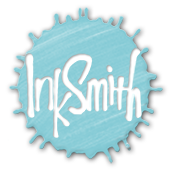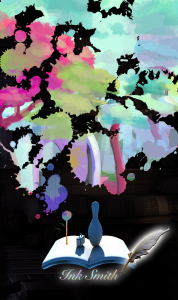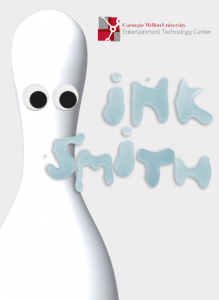This week, Inksmith dove into the thick of development for our first storybook prototype, working towards a playtest of our planned interactions by the end of the week.
Our first step was to readjust our core hours once more. Electives among the team had updated once more, and it resulted in freed up time slots on Mondays and Wednesdays. Our new (and hopefully final!) core hours are shown below:
- Mon: 11 AM – 4 PM (5 hrs)
- Tues: 5:30 PM – 9 PM (3.5 hrs)
- Wed: 1 PM – 7 PM (6 hrs)
- Thurs: 5:30 PM – 9 PM (3.5 hrs)
- Fri: 11 AM – 6 PM (7 hrs)
Inksmith’s branding is also in progress. We are developing a team logo, poster, and descriptive half-sheet. Some of the initial designs are shown below.
We will continue developing our branding material according to faculty feedback we obtain over the next week.
To kickstart our interaction development, we created storyboards that followed the manuscript given to us by Josie. Some of these are linked below:
Storyboard1 Storyboard2 Storyboard3 Storyboard4 Storyboard5
The storyboards include a lot of interactions that may not be able to make it into our prototype due to time constraints, but we included them in order to prioritize what we felt was important and engaging to kids, and give us something in the future to work to include if we had time.
We brought the storyboards to discuss with Josie on Wednesday morning, as well as a more in-depth discussion about the semester’s objectives and milestones. Josie let us know that her expectation for the semester was to develop 3 different storybook manuscripts rapidly. At the last month or so of the semester, we would choose which of the 3 stories we wanted to continue working on and polish it. Through these prototypes, we could see what interactions we set up could be more universally applied in different stories and still feel integrated and engaging to kids. We set up the following prototype deadlines:
- Prototype #1: Done by Oct. 2
- Prototype #2: Done by Oct. 23
- Prototype #3: Done by Nov. 20
These deadlines give approximately 3 weeks for each prototype, adjusting for time that the team would use to prepare for presentations and playtesting. The storyboards made discussion on the prototype much more clear and directed, and it was agreed to complete storyboards early on in the timeline of a storybook prototype to make discussion about it as efficient as possible.
In prototype development progress, we recorded scratch audio of all the narration for the whole manuscript. With these, we were able to start developing a dialogue structure for showing the lines of the story and syncing the narration along with it. As of now, the narration audio always plays, and the guest can only move forward, not go back to previous lines. As far as art and implemented interactions, we completed the scene interactions through the first page of storyboards, which amount to two different scenes to travel through. This is a small fraction of the overall manuscript, but we hope that now having the infrastructure to build scenes and add the lines of the story will allow us to create the rest much faster.
We brought these beginning interactions to the Children’s Museum of Pittsburgh to playtest with the children there on Friday morning. We left an iPad and iPhone at a table with the book and sets of crayons with paper to make the station more inviting to children, then observed how kids interacted with the app. We saw a variety of children come up, some with their parents, others in big school groups, and some just by themselves. We took down notes of what we observed and learned for future iterations, then sent out the observations to the team, our faculty advisors, and Josie for review.
Next week:
In order to keep up with a 3 week iteration cycle, our main goal next week will be to complete a beginning to end, “complete” prototype that connects all lines of the story manuscript together. Meeting this deadline will likely mean that backgrounds and interactable objects will be very simplified for the sake of stringing scenes together with dialogue appearing on it, but we will do what we can to meet this deadline.
We will also continue on our branding, hopefully finalizing our poster and logo designs as well as writing our half-sheet description this week. We will also begin to prepare for our quarters walkaround presentations on Week 5, where the faculty will come in and look at the work we’ve done so far.


